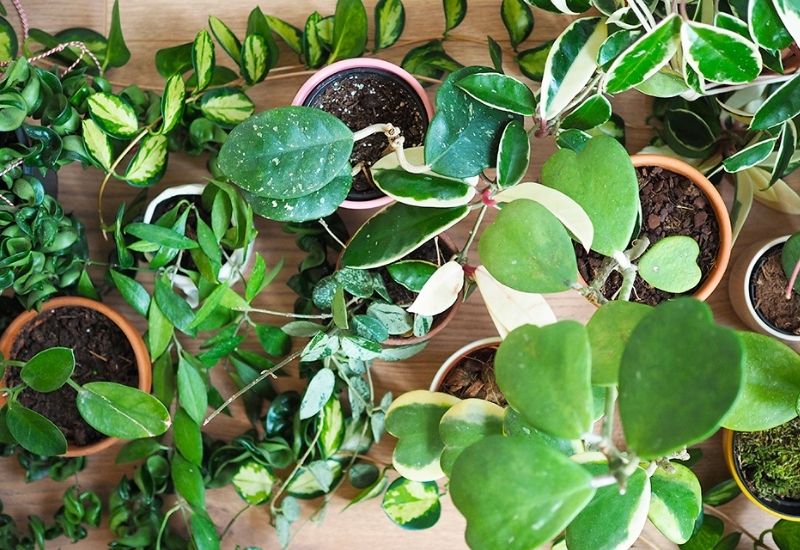
Exotic, flowering and fragrant, hoya is a group evergreen semi-succulent tropical creepers, vines or even some shrubs that make excellent houseplants.
Also called waxplant, waxvine or waxflower, this will give you an idea of the quality of the star shaped round clusters of blooms and glossy leaves.
Under the right conditions, some Hoyas can flower almost all year round and fill the whole house with their tropical fragrance!
Despite their tropical look, the hoya is a low maintenance indoor plant that will surprise you with the beauty of its fleshy leaves, waxy flowers with extraordinary colors and shapes.
Originating from South and South East Asia as well as Polynesia and Australia, the amazing genus of Hoya, which is part of the huge Asclepiadaceae family, includes between 200 and 300 different Hoya species but about 40 to 50 varieties of Hoya plants have made it into garden centers and from there to private homes and gardens, including cultivars and hybrids.
From common Hoya species such as the wax flower gracilis to real rarities such as the Hoya callistophylla here are 40 most beautiful types of Hoya plants that will make an excellent addition to your indoor or outdoor garden.
Along with the plant descriptions and pictures, to help identify each species of Hoya so you can take better care of your Hoya.
Hoya Plant Colors And Shapes

Botanist Robert Brown gave the name hoya to this species to honor Thomas Hoy, the Duke of Northumberland’s head gardener who specialized for many years in the cultivation of tropical plants in greenhouses.
Hoya is a genus of tropical plants, mainly epiphytic vines, with interesting flowers and foliage.
It originates from humid forest regions of South Asia and Oceania, where it often grows on trees, though sometimes in rocky environments as well. Only a few species are shrubs.
Hoya is well knows for its flowers; these can be of many colors (white, yellow, orange, red, purple, etc.), but they are always star shaped, though sometimes these are joined into a cup form. The five petals also contrast with another star in the middle, called the corona. This containers the reproductive organs, but what you see is like two flowers, one inside the other.
The two contrasting colors have a good decorative effect, and the round inflorescences called umbels often pack them together in a showy display.
The blooms appear as if made of wax, almost succulent in texture. Most Hoya types have small flowers, but some, like Hoya imperialis and Hoya coriacea can have individual blossoms that are 3 inches across (7.5 cm) and the umbels can be 12 inches in diameter (30 cm).
The inflorescences come on spurs, which will start off before they actually blossom. These look like new, soft stems with a embryonic cluster of flowers at the tip. Some flowers give off a strong fragrance and secrete a sweet, transparent nectar that attracts pollinating insects, especially at night when they smell the most.
The leaves of Hoya plants are elliptical, usually glossy as well, mainly mid green but there are some variations. The size can vary a lot from 1/5th inch long (0.5 cm) to 14 inches (35 cm) depending on the variety.
It is mainly grown as a houseplant; it is not cold hardy and it grows best in protected environments and in a light growing medium, not in full soil, though it is still possible.
And for a few facts about waxplant, read on…
Hoya Factsheet

For a reference guide on the Hoya genus and all its varieties, we have devised an easy to use fact sheet for you.
How to Care for Hoya Plants
If this has convinced you to look for a waxplant to take home, you will need a few detailed tips on how to look after it. A care guide you can keep with you.
Hoya Lighting Requirements
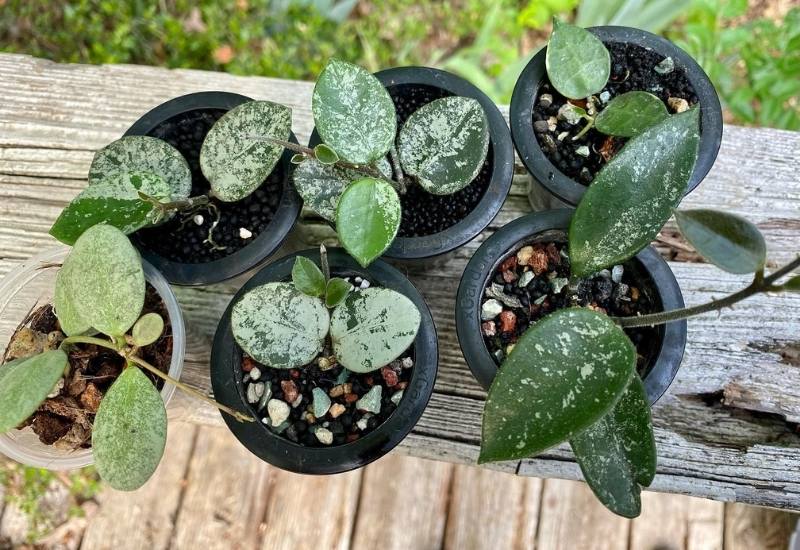
Hoya wants plenty of bright indirect light but it does not tolerate direct and strong sunlight at all. Remember that it grows in the canopies of trees in its natural environment.
It prefers a south or east facing window, as it prefers afternoon shade. Place it at least 5 to 8 feet from the window (1.5 to 2.4 meters), according to how strong the sunlight is where you live.
How to Prepare Good Hoya Potting Mix
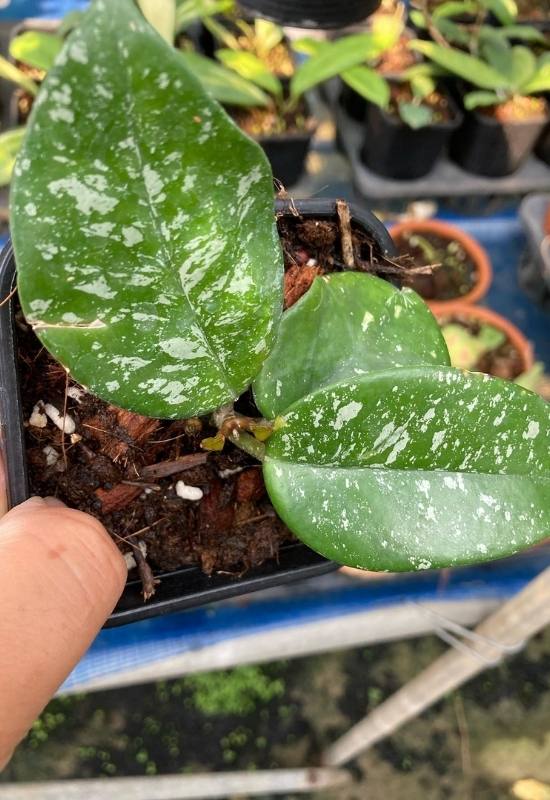
In a container, Hoya does not want any soil. It is more like an orchid in this respect, because most varieties we grow indoors are epiphytes.
Instead it needs a growing medium, which needs to be mildly acidic and well drained. A good mix could be:
Hoya Watering Routine and Requirements
Hoya needs humidity; it comes from very rainy regions and like all epiphytes, it also needs it to absorb nutrients from the air. But it has different needs in summer and in winter.
In spring and summer, water your Hoya plant every time the top inch of soil (2.5 cm) dries up. Use room temperature water and soak the growing medium thoroughly. But do not leave water in the saucer; that may cause root rot. In summer, bathe the foliage with soft, lukewarm water, without however wetting the flowers or the buds.
Reduce watering starting in fall and all through winter. By wintertime your aim is simply not to let the soil dry up completely, though you will want it to be mostly dry, because your plant will simply drink far less in this season.
Hoya and Its Humidity Needs
A tropical plant, Hoya like humid air as well. Spray misting your your Hoya may help, especially in summer or in the dry season where you live.
You could however place a second saucer or tray under your waxplant so that it does not touch the growing medium or roots and fill it with water to increase the level of humidity around the vine.
How to Feed and Fertilize Hoya Plants
Hoya needs regular feeding; usually once a month. Use a good organic fertilizer mixed in with the water.
The NPK should be about 2:1:2 or 3:1:2 when it is growing (in the vegetative phase) but about 8 weeks before bloom time, switch to 5:10:3.
How and When to Repot Hoya Plants
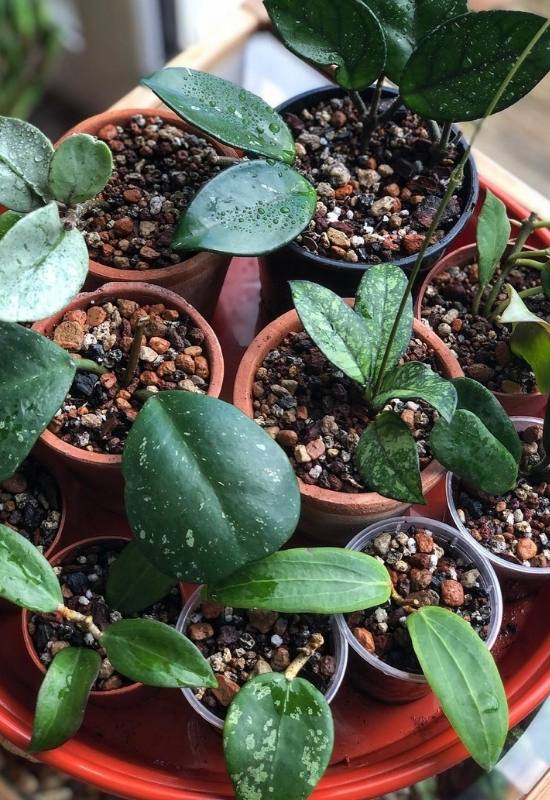
You can repot your hoya if it has really outgrown the container, or to change the growing medium. In this case, be very careful if it starts smelling or it degrades in any way.
When you first buy your wax-plant, repot it and check that it has no root ball. If it does, break it. A root ball is a clump of actual soil that forms under the very base of the vine.
This happens because nurseries use light soil to start them off, rather than a growing medium. If you leave it, your plant may die of root rot.
Remove the vine from the pot, discard all old potting mix. Disinfect the new (or old) pot; place the roots in the middle and gently cover with a fresh mix. Water.
How You Can Prune Hoya Vines
Pruning Hoya plants can encourage flowering. In fact, new buds will come on newly grown vines. Like with all climbers and creepers, pruning Hoya is necessary but also very easy.
How to Propagate Hoya Plants
Stem cuttings in the spring and summer are the easiest way to propagate your hoya plants. And it is simple!
This way you can have many plants of hoya from a single one you buy. But you cannot change variety, so, which one is best for you? Up next…
40 Hoya Plant Varieties to Take Your Plant Collection to the Next Level

With natural species from the tropical regions waxplant comes from, and with many cultivars and hybrids of Hoya we have bred in the last 100 years, here are the 40 stunning Hoya varieties to come and live with you, as a houseplant or in your garden.
1: Giant Wax Plant (Hoya lauterbachii)
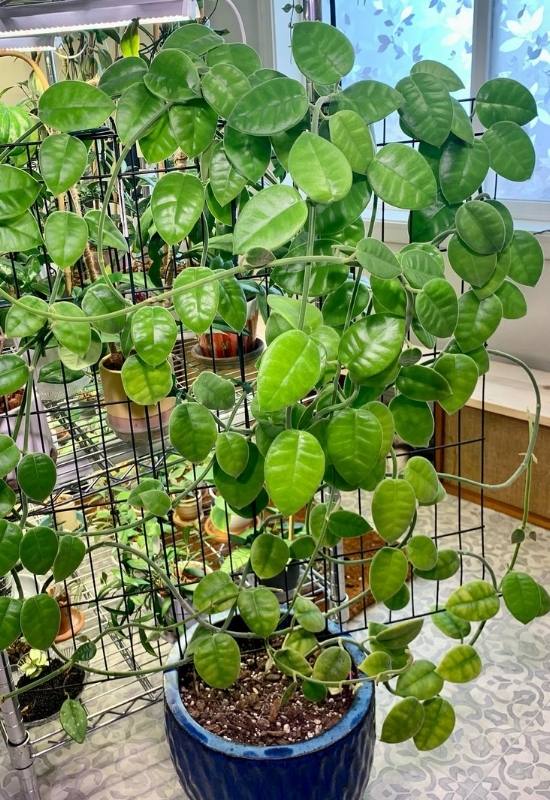
Giant wax plant is true to its name; it is one of the most showy varieties of hoya you can ever have, and its special quality is that the very fragrant blooms are massive!
Each individual flower is about 3 inches across (8.0 cm), the size of a tea cup. And it even looks like one! The petals are joined in a bowl shaped which has a bright canary yellow center and ruby to purple edges.
The corona, on the other hand, is golden yellow. This gives you a very stark color display. The clusters or umbels are literally huge, with up to 12 blooms each, and 1 foot in diameter (30 cm)!
The leaves are glossy, waxy and mid green and this vine can grow taller than a man. It is in fact, one of the few varieties that are suitable for outdoor growing.
2: Porcelain Wax Flower (Hoya carnosa)
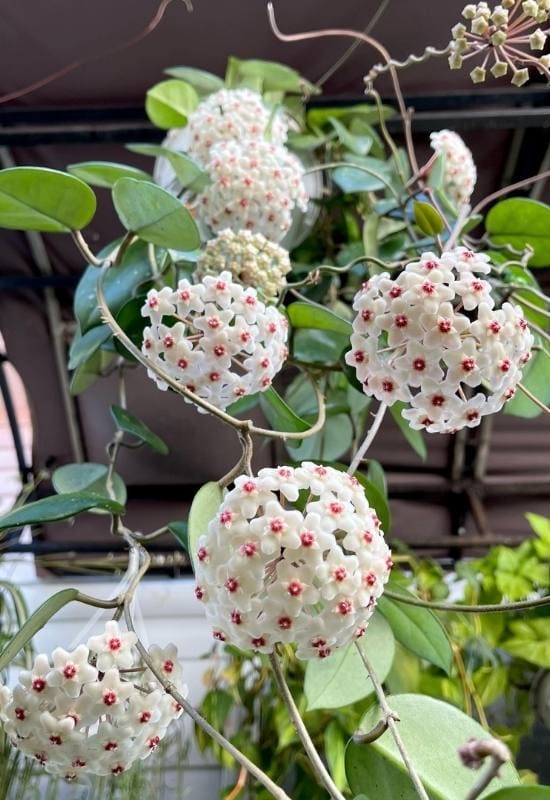
Porcelain wax flower, Hoya carnosa is a classic small variety of waxplant that you can find in many garden centers.
The sweet smelling and star shaped blooms are white with a pink fade to them, while the internal corona is dark red.
They are quite small and they form beautiful round clusters amid the vines. The leaves are elliptical and mid emerald green on top, light green, almost lime, underneath.
But they are also quite glossy and attractive. It is a small variety, perfect even for coffee tables or maybe in hanging baskets.
3: Hoya Pubicalyx (Hoya pubicalux)
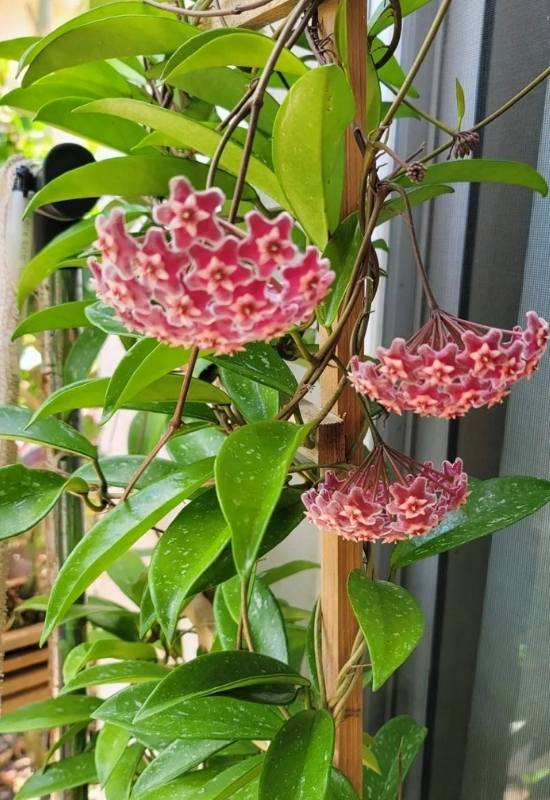
Hoya publicalyx is a sought after houseplant for some very individual qualities; in fact the leaves are very glossy and lush, mid to dark green in color, and very exotic looking.
The ‘Pink Silver’ cultivar has variegated foliage as well, with white to silver gray specks that make it very decorative.
Even the flowers are quite original and distinctive; they are still waxy and very fragrant, especially at night but they are known for being lightly fuzzy too.
The color is usually on the pink to dark magenta range, sometimes with white and cream parts.
However, if you want a really striking variety, ‘Black Dragon’ has very dark purple violet petals and a red magenta corona in the middle.
4: Hoya Burtoniae (Hoya burtoniae)
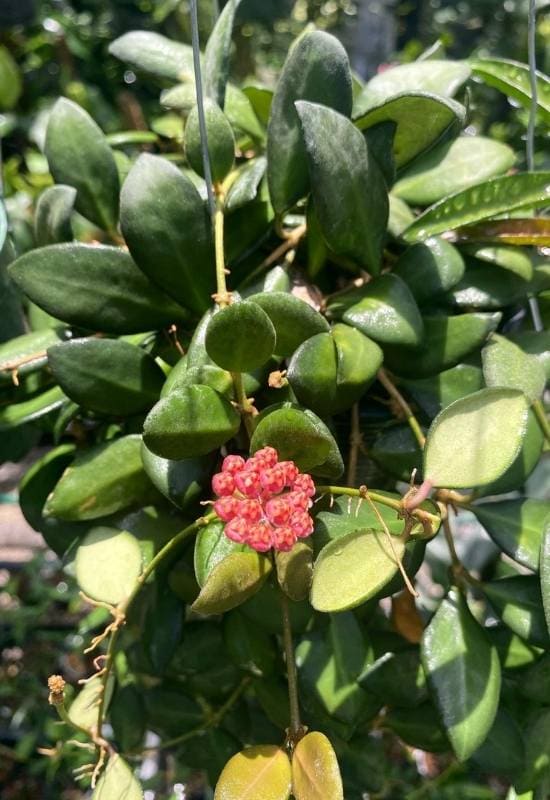
You will recognize Hoya burtoniae by the original color of its foliage. The short elliptical leaves appear as very pale green in the middle with a thin dark brownish green rim around the margins.
The effect you get is very delicate, with a pastel palette, but clearly defined lines. The clusters of flowers are of a very peculiar and bright shade watermelon pink, but the open in small nodding clusters of deep fuscia that look like berries.
The petals reflex as they mature, and the blooms are loved in all their phases, as they keep changing look. It is ideal for hanging baskets in elegant and brightly colored indoor space.
5: Hoya Linearis (Hoya linearis)
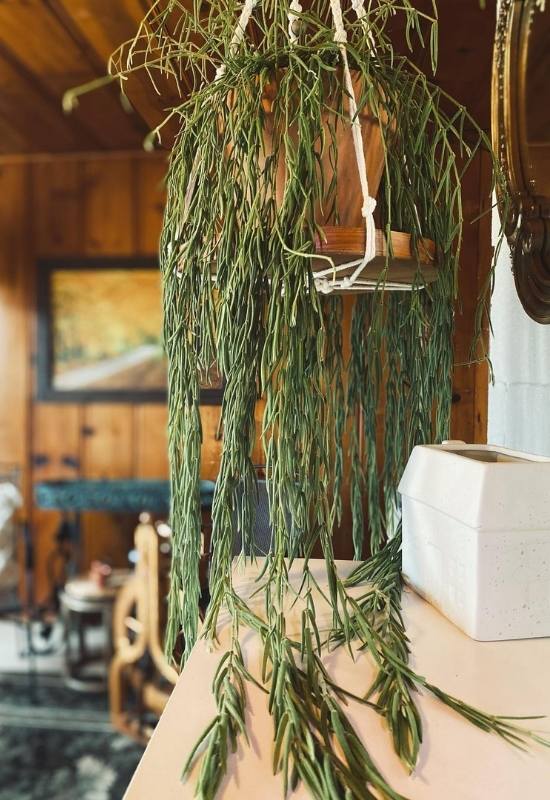
The Latin name of this vine means “linear hoya” because of a very distinctive feature of this houseplant. In fact, the leaves are not elliptical at all.
You will see what looks like a series of green beans hanging from baskets, because the foliage is thin, long and elegantly curved. It is also slightly fuzzy, but you won’t notice it from a distance.
They grow alternate on very thin and green draping vines. What is more, the flowers are fully white, with a dash of lemon yellow in the middle and they in small but very bright hanging inflorescences. This is the variety you want for a light and breezy look, even in a minimalist environment.
6: Imperial Hoya (Hoya imperialis)
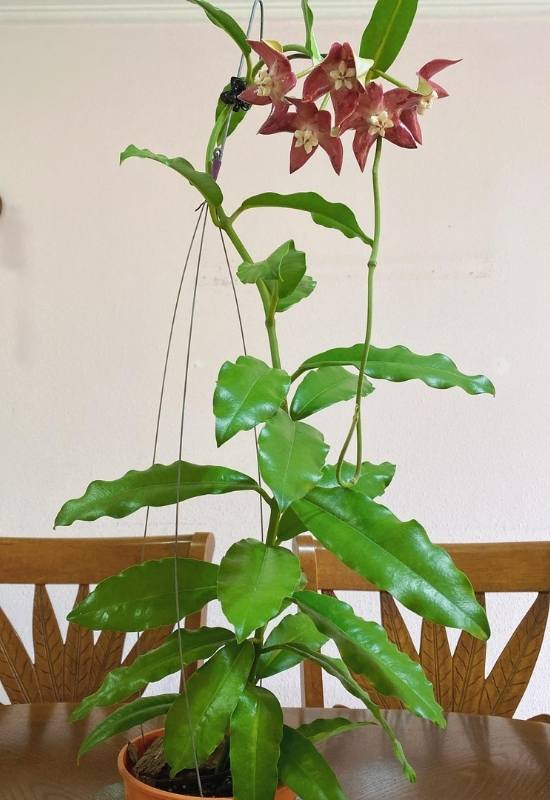
Imperial hoya, or Hoya imperialis has some of the largest flowers of all this genus of plants. They can reach 3 inches across (8.0 cm) and in clusters of 1 to 19.
But it’s not just the size that makes them stand out; the blooms are deep ruby red with cream white coronas in the middle.
They are also very waxy and they appear almost succulent. This gives you an exotic and very energetic display.
The leaves are thick, fleshy, mid green and 2 to 6 inches long (5 .0 to 15 cm) and 1 to 2 inches wide (2.5 to 5.0 cm).
It has all the beauty of tropical houseplants, perfect for large displays. It is also a fast growing vine, sometimes hard to keep up with.
7: Hoya Retusa (Hoya retusa)
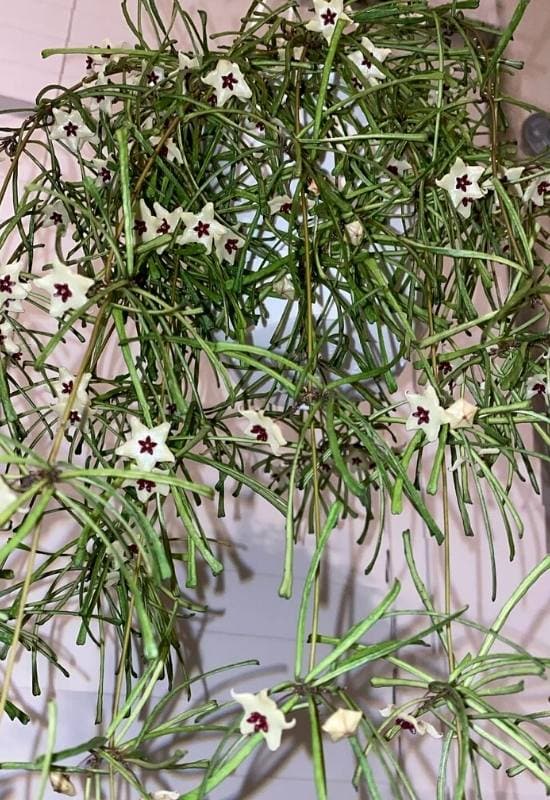
Hoya retusa is another original looking variety of this vine, for two reasons… To start with, the leaves are long, thin and with a flat tip.
They look like strings of deep emerald green with lighter specks on them, and they are particularly glossy, excellent for light effects.
The flowers are medium sized, white and with a purple red corona, they don’t always grow in umbels. In fact they often open individually and look sideways and slightly down.
This makes it ideal for a high position in your house or office, like on top of a shelf or cupboard, where it will provide excellent decoration and it will soften hard hedges.
8: Hoya Obovata (Hoya obovata)
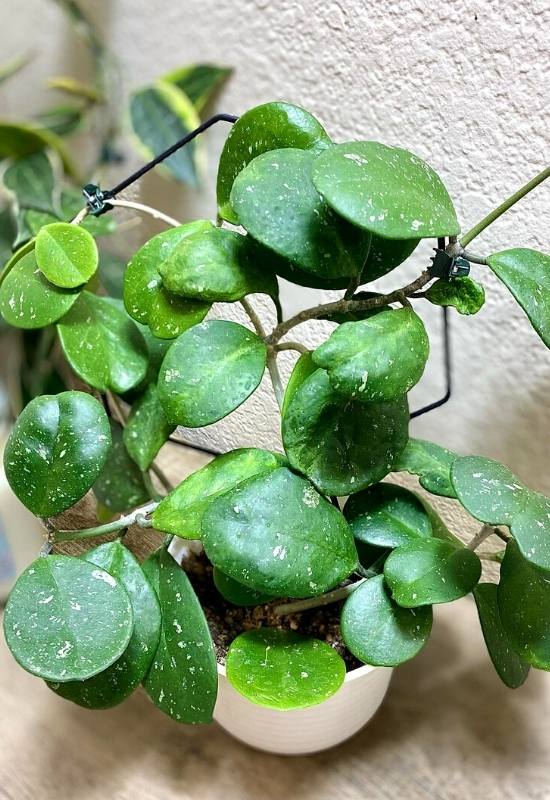
Hoya obovata has unique foliage that set it apart from other varieties. These are very fleshy, almost succulent, and usually ovate, not elliptical but you do get the odd one that’s parted in the middle, like a heart.
They are glossy and bright emerald green with lighter specks decorating them. The vines are quite strong, silver green and the umbels nod from them with very bright flowers.
In fact, they are of a strange white with a pink undertone and deep magenta centers. It is a very sculptural houseplant, with a very exotic and showy presence and personality, ideal for bright rooms.
9: ‘Lisa’ Hoya Australis (Hoya australis ‘Lisa’)
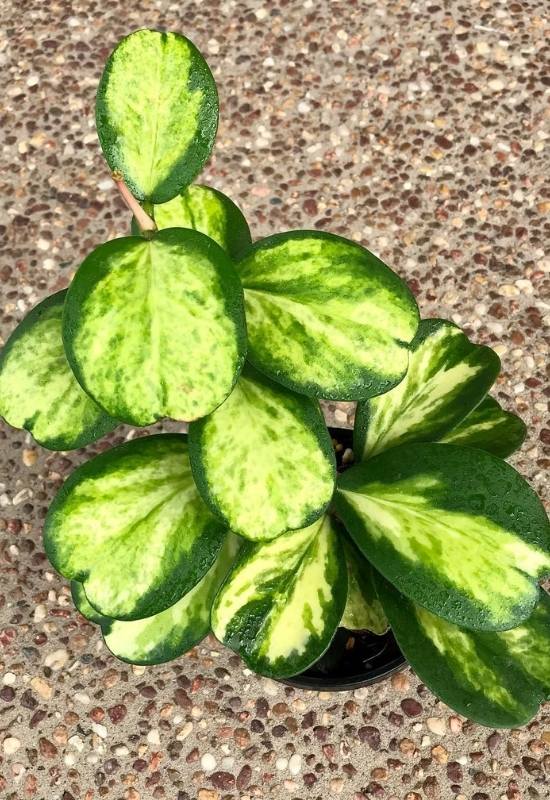
Hoya australis ‘Lisa’ is the waxplant you want for its original foliage coloring and candid blooms.
The elliptical leaves, glossy like with all waxflowers, are variegated, with a bright yellow green center and then patches that become darker and darker towards the margin, till you get a very dark shade indeed at the very edges.
You may even get some pink overtones in the tight conditions. The fragrant blooms on the green to purple vines have longer petals compared with other varieties, and they make a wonderful contrast with their snow white color!
10: Hoya Wayetii (Hoya wayetii)
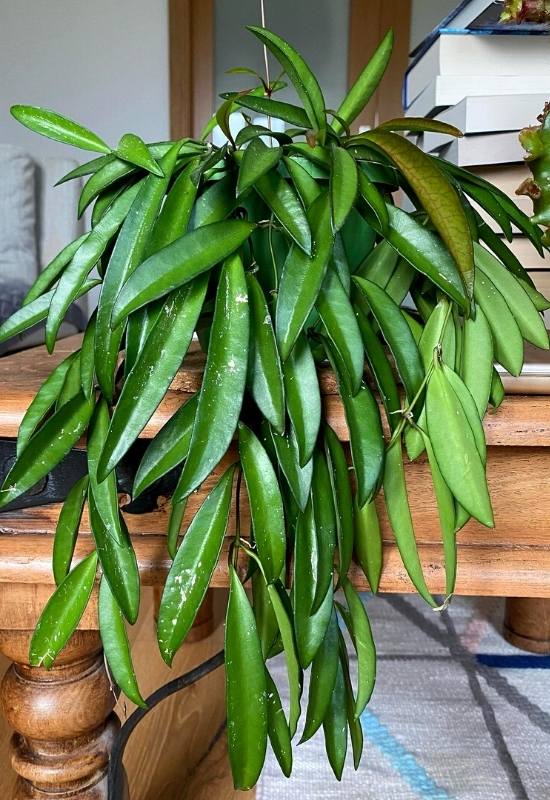
Hoya wayetii is another variety you will very much appreciate for its foliage. The leaves are long, leathery pointed and very glossy indeed, they look like canoes.
They form exotic looking and florid shrub like clumps of mid emerald green but also with other tints, like lime and even some copper tones.
The umbels contain small flowers with joint petals, like small pentagrams, and they are lemonade pink on the outside and dark ruby purple in the middle.
This is a super elegant vine, with a very fine and original texture, really reminiscent of rain forests and lush exotic places.
11: Hoya Macrophylla (Hoya macrophylla)
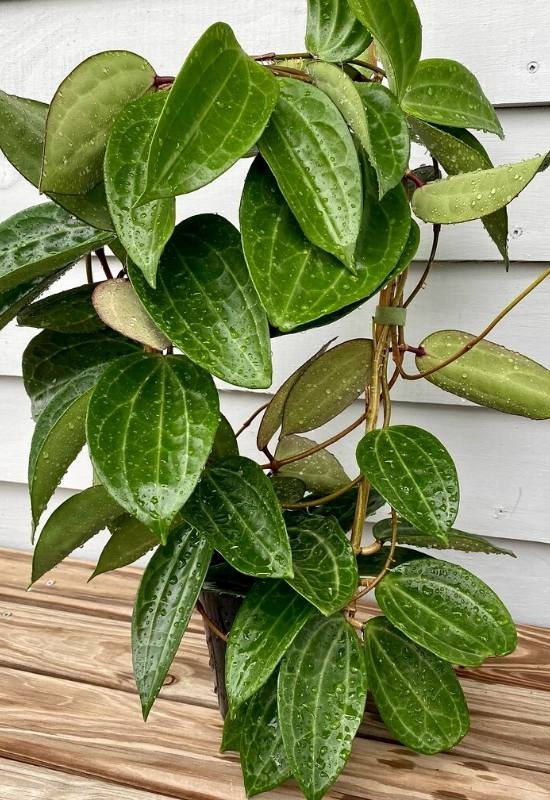
Hoya macrophylla is distinguished by its huge foliage. The leaves are 6 to 8 inches long (18 to 20 cm) and 2 to 3 inches wide (5.0 to 8.0 cm).
They are fleshy, glossy and colorful as well. In fact, this species has a beautiful pattern of raised veins that cut the rich green of the background.
These are of a lighter shade, giving you both texture and color. There are also variegated varieties like Hoya macrophylla albomarginata, with cream white edges, or Hoya macrophylla variegata with yellow stripes along the margins.
The flowers have long petals, white with pink blushes and they come in clusters of up to 30. These qualities make it an excellent houseplant.
12: Hoya Coronaria(Hoya coronaria)
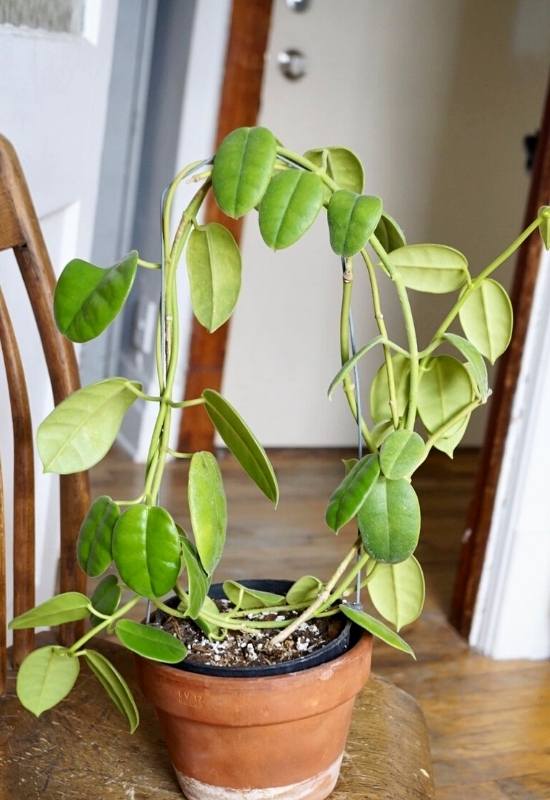
Hoya coronaria is a waxplant with bright mid green leaves with a soft fuzz on them; they are broad, fleshy and slightly curved, like a paddle in fact.
On the underside, you will notice a straight rib running across the whole leaf. They are 6 inches long (15 cm) and 3 inches wide (8.0 cm).
The blooms too are medium large, about 1.5 inches across (4.0 cm) and they are particularly hard to the touch.
They look like starfish, with pointed petals and they come in small clusters. The blooms can be of different colors: white with canary yellow coronas, yellow, pink, red and sometimes with yellow tips or even maroon. This is a very showy variety for indoor spaces or tropical gardens.
13: Hoya Finlaysonii (Hoya finlaysonii)
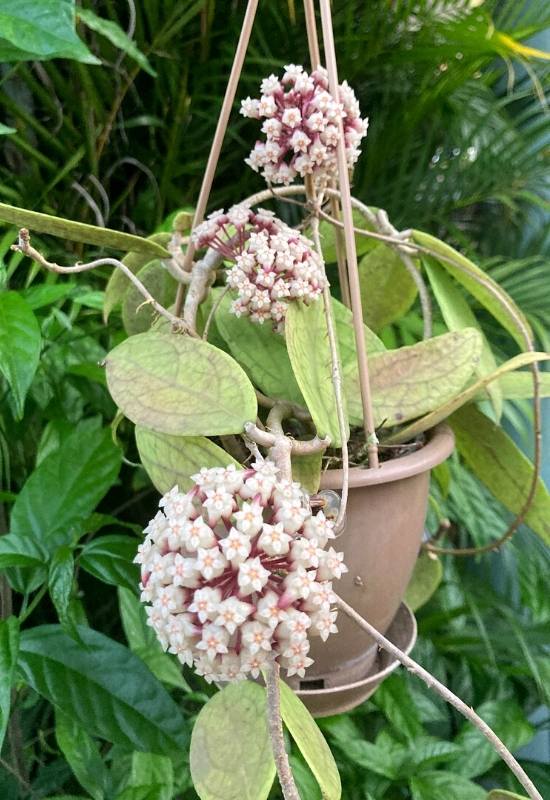
If we could give a common name to Hoya finlaysonii it would be “crocodile waxplant”. The leaves in fact are best described as alligator skin.
Waxy but thin, in fact, they have a pattern of darker green lines and a paler but rich green background. They are long (6 inches, or 15 cm) and pointed, and they grow on light brown vines that look quite hard rather than soft.
The flowers come on spherical umbels, packed with many blooms. Each has orange to purple margins, while the corona can be white or even yellow. These “balls of blooms” among the very decorative foliage with its exotic texture make it a very prized houseplant.
14: Hoya Pachyclada (Hoya pachyclada)
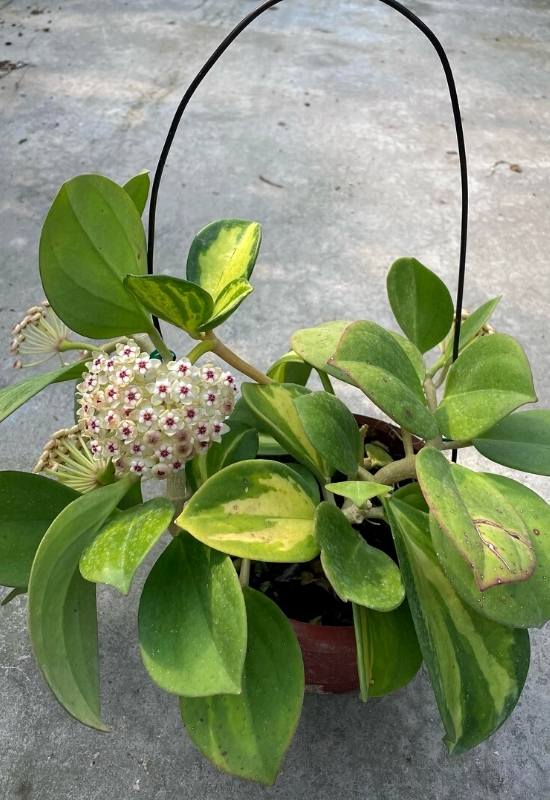
The name of this waxflower, Hoya pachyclada, describes this plant perfectly, because it means “with thick branches”.
Indeed this is an almost succulent variety, large, broad and very fleshy leaves with a delicate slightly pointed tip.
They are of a delicate shade of matt jungle green, though they can also be light emerald green. This may depend on the light conditions, in fact, some plants even take on purple shades. It is also a small species and very slow growing.
The blooms come in thick nodding umbels of up to 30 and they are fleshy, of course glossy and snow white. While it looks like a succulent, it will need regular watering, like all other plants of this genus.
15: Hoya Fitchii (Hoya fitchii)
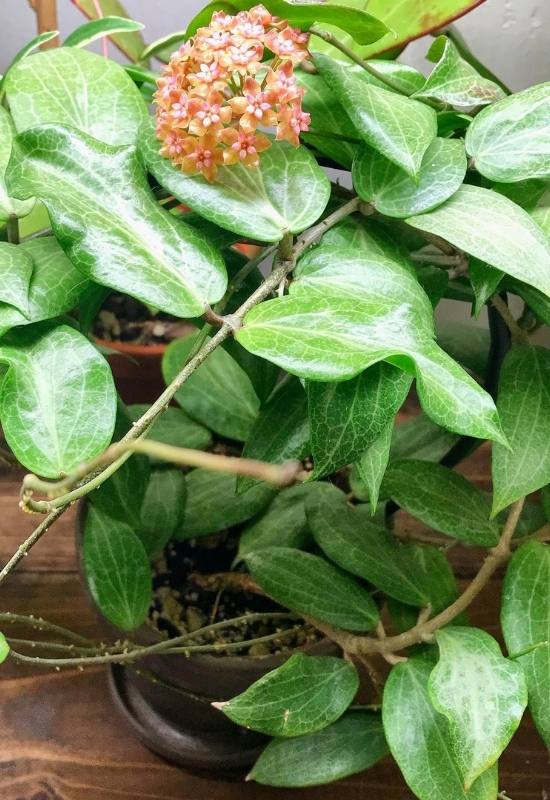
Hoya fitchii has unique patterns on its foliage that make it very delicate, very elegant and very fine looking.
The leaves are pointed, fairly broad and light fern green in color, but they also have a pattern of almost white lines, like a cobweb, that give it an amazing texture.
These grow fairly spaced on the thin but strong vines and they are best admired close by, like on a coffee table or work desk.
The blooms have an almost translucent quality, and they range along the watermelon to peach pink, sometimes with an accent of purple on the tips. Each umbel can have about 24 little blossoms. It is also easy to train to grow upwards.
16: Hoya Memoria (Hoya gracilis)
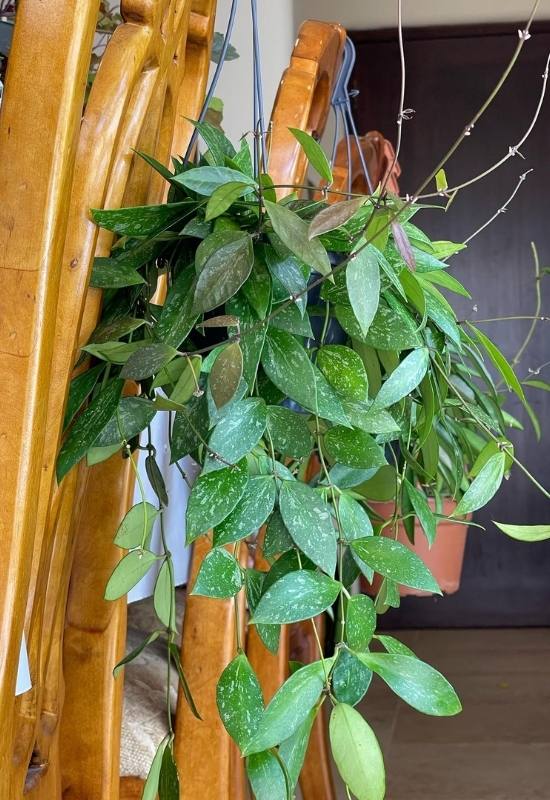
The Latin name of hoya memoria, i.e. Hoya gracilis describes it perfectly well: it means, lean, slender, or slim.
This look comes from the thick foliage, which is made up of hard, long and pointed elliptical leaves that are dark green with brighter specks that improve its texture.
Each one can grow to about 4 inches long (10 cm). They grow on thin trailing branches too, adding to the elegant effect.
The flowers are very small and they come on umbels of about 20. They are light watermelon pink with purple red coronas, and the petals reflex as they mature.
Overall, this is a delicate looking plant, ideal for a touch of sophistication in any tidy living or working space.
17: Hoya Shepherdii (Hoya shepherdii)
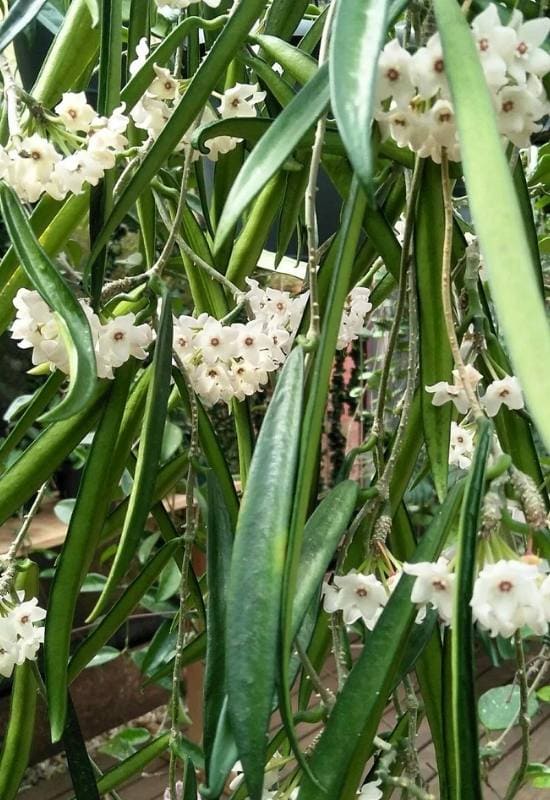
Hoya shepherdii has unmistakable foliage. Each leaf is very long and thin, like a blade of grass, and they grow in opposite pairs in soft vines.
With a minimum length of ¼ inch (0.6 cm) and a maximum of 12 inches (30 cm), you also get a lot of variety in the texture.
These are usually green, ranging from mid to dark, but some plants even take on a dark blue tint, which makes them really exceptional.
The flowers can be snow white but sometimes they have a very pale lime or cream yellow tint. The center of the corona is darker, either red or saffron. The petals are wide and then they taper to a thin tip. Overall, it has an exotic but also elegant, delicate look.
18: Hoya Affinis (Hoya affinis)
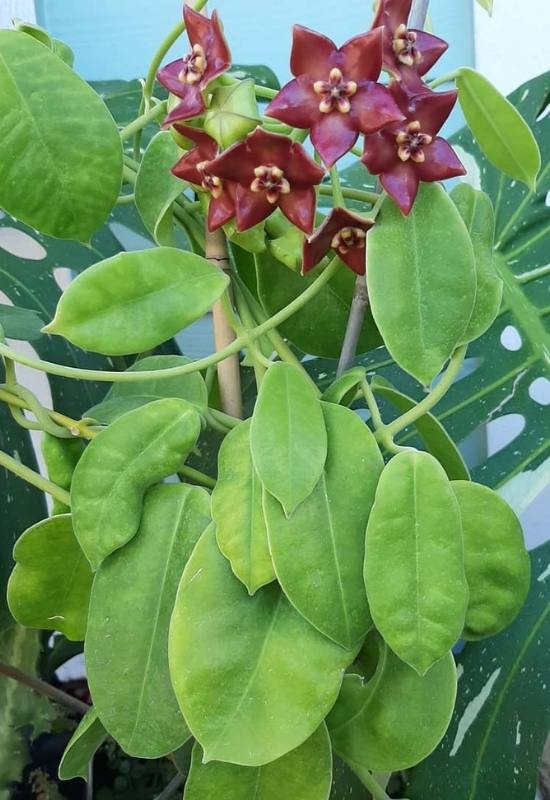
Hoya affinis has an upright habit, so it is easy to train it on trellises and stakes. The leaves are thick, fleshy and succulent like, usually of a bright emerald shade, but the color can change according to light conditions.
Each can be about 3.5 inches long (9.0 cm) and about 1.7 inches wide (4.0 cm). The waxy flowers can be of many different colors.
The bight fiery red varieties are the most common, but really the range is huge, from coral to deep purple and including maroons and pinks.
Then petals are pointed and the corona is always of a different hue from them. And the umbels can have 10 to 12 heads each.
19: Hoya Multiflora (Hoya multiflora)
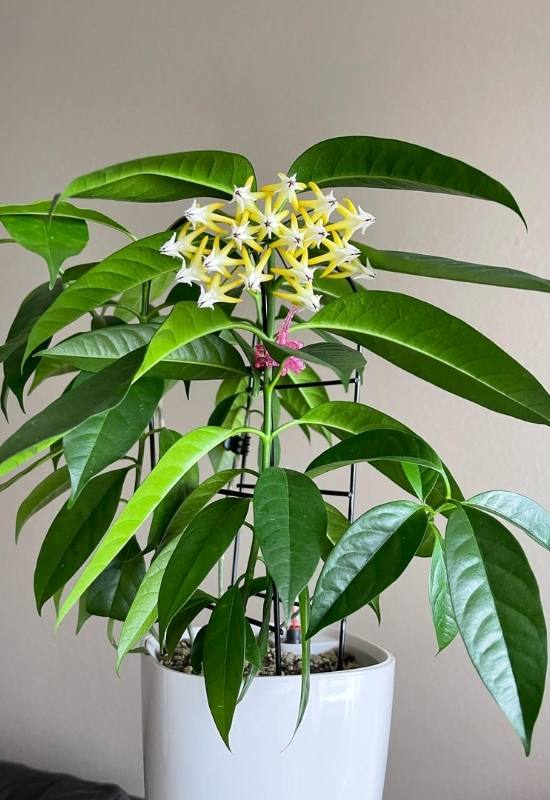
Hoya multiflora us a very distinctive waxplant with dark foliage and unusual blooms, and it looks like it would fit well in a forest, even a temperate one.
The foliage is long, elliptical and pointed, arching and dark green. The leaves are big, up to 8 inches long (20 cm) and 3 in width (8.0 cm).
They also have a waving quality to them. The flowers are really unique; they look like arrows because the petals are very reflexed, pointing literally backwards; they are white or yellow, ranging from lemon to saffron.
The corona, on the other hand, extends forward, and it is white. For this reason, the clusters form an intricate pattern, like you would expect in a Gothic cathedral. Of all the waxflowers you can grow indoors, multiflora is among the most sculptural.
20: Hoya Sigillatis (Hoya sigillatis)
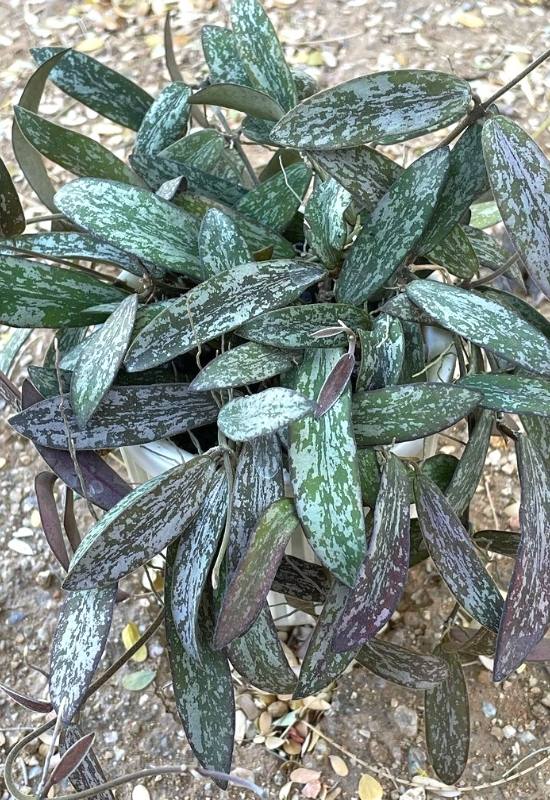
Hoya sigillatis will form a dense clump of lush foliage that trails mad drapes beautifully from hanging baskets.
The leaves are elliptical and elongated, but what makes the texture fantastic is the variegation of dark and light green patches that balance of with great harmony.
However, with the right light conditions this combination can shift onto the red scale.The vines are brown and semi hard.
The blooms are small and with joint and partly reflexed that form an orange pentagon with lovely yellow star rays in the middle.
The umbels have an open habit and they usually occur at the tips of the vines, hanging down under the plant. As a houseplant, this variety of waxflower has great qualities, and you can also grow it outdoors.
21: Variegated Hoya Acuta (Hoya acuta variegata)
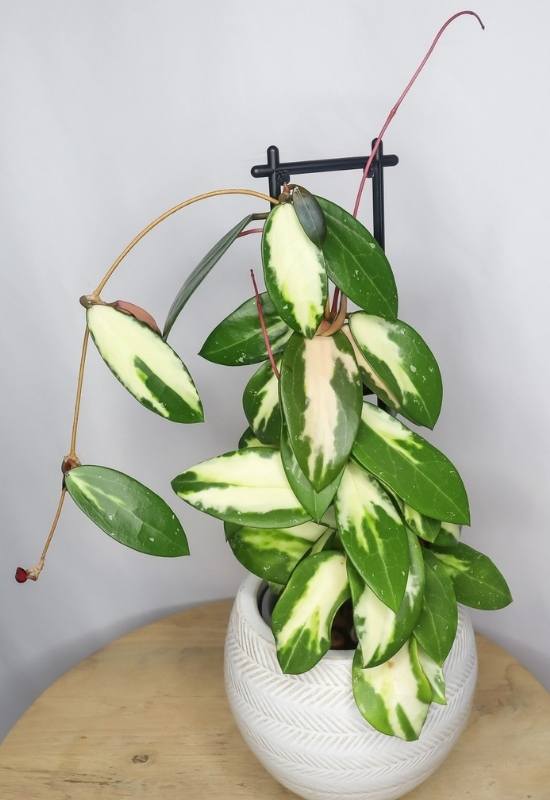
Hoya acuta variegata is a climbing variety of waxflower, and one of the easiest to grow. The leaves are ovate, with soft and round tips, and the middle is bright lime green, while the margins are mid emerald green.
But this is not the only reason why it is an excellent and decorative houseplant. The umbels are very thick and they can even form a spherical cluster of tightly packed little flowers.
Star shaped and waxy as you would expect, these are white with pink coronas, or sometimes yellow. This cultivar is one of the most popular on the market also because it is a generous bloomer and one of the least troublesome of all the waxplants.
22: Hoya Pauciflora (Hoya pauciflora)

This waxflower species is called Hoya pauciflora because its leaves are very small. In fact it must be one of the varieties with the least thick foliage.
They are light green, with a rib in the middle and 1 to 3.5 inches long (2.5 to 9.0 cm) but very thin indeed, and you only get a pair at each node of the soft and draping vines. But there’s more that makes this type of waxplant distinctive…
The blooms appear individually, and not in cluster. They are very fragrant and star shaped, fleshy and pure white with deep dark purple coronas.
They are very visible among the thin foliage and they hang facing outwards, for a perfect elegant but showy effect.
23: ‘Langkelly Ck.” Waxflower (Hoya macgillivrayi ‘Langkelly Ck.’)
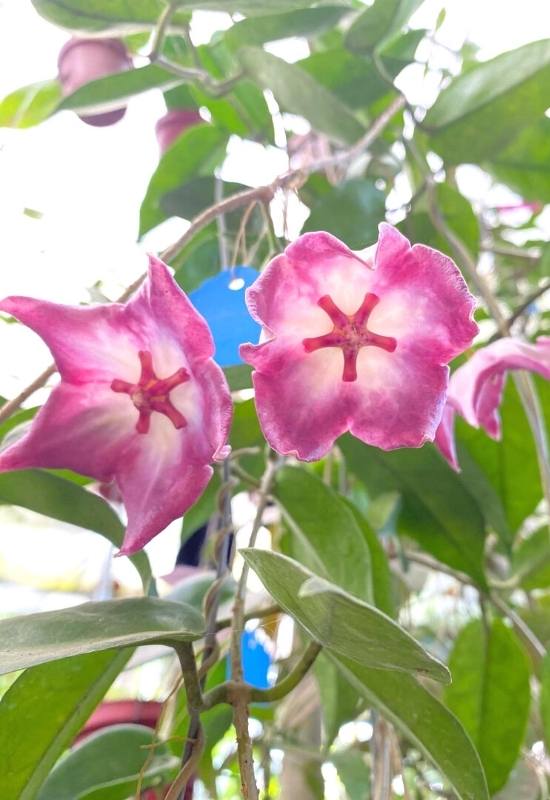
I picked ‘Langkelly Ck.’ waxflower, a cultivar of Hoya macgillivrayi because of its amazing blooms! They are large and super showy.
In fact they have a light purple center and the margins are very deep dark purple. They also have a strange, cupped shape with five points, like decorative saucers, and they are huge!
In fact each can reach 2.7 inches across, or 7.0 centimeters, and the clusters can be 10 inches in diameter (25 cm). What is more, they are very, very fragrant.
The glossy leaves are elongated and ovate, bright green and pretty. However, the winning factor of this variety is certainly the spectacular blossom.
24: ‘Speckles’ Waxplant (Hoya kerrii variegata ‘Speckles’)
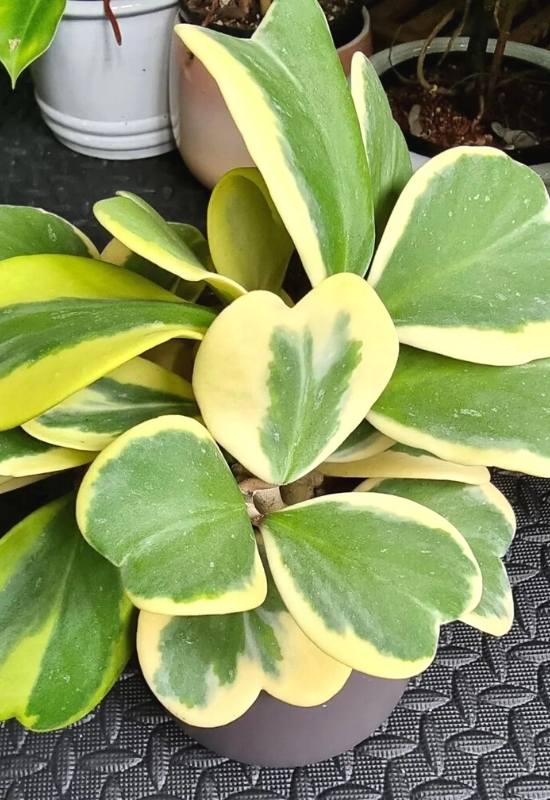
For a cultivar with of waxplant with very unusual foliage, I would suggest Hoya kerrii variegata ‘Speckles’, and I’ll tell you why… The leaves are heart shaped, very fleshy and almost succulent, up to 3.5 inches long (9.0 cm) and broad as well.
They are extremely glossy and what is more they have three different shades of green in them, starting with very pale in the middle, then pea green and finally mid to dark emerald towards the edges.
It is a small plant, and each umbel of flowers will have up to 30 blooms with white joined petals that form rounded pentagons and purple coronas in the middle. This slow growing variety is ideal as a centerpiece for an elegant coffee table.
25: Hoya Cystiantha (Hoya cystiantha)
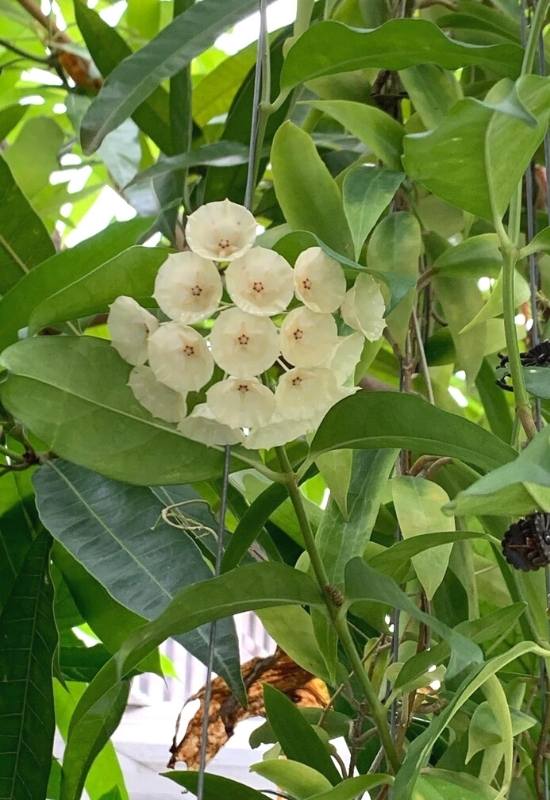
Hoya cystiantha is a variety of large flowers you will love for its large, fragrant and unusual flowers.
The blooms, in fact, are cup shaped, and they look like pretty deep bowls. This sets then apart from all other species and cultivars.
They are of a lovely cream color, sometimes edging onto butter, and the corona in the middle is visible and star shaped, with five very tiny purple dots.
They come in umbels of up to 20, and each blossom lasts for about two weeks. The leaves are mid green, elliptical and 5 inches long (12 cm).
They are thin, glossy and arranged in opposite pairs along the green stems. The unusual shape of the flowers make it a very exotic presence for indoor spaces.
26: ‘Purple Pride’ Waxplant (Hoya carnosa variegata ‘Purple Pride’)
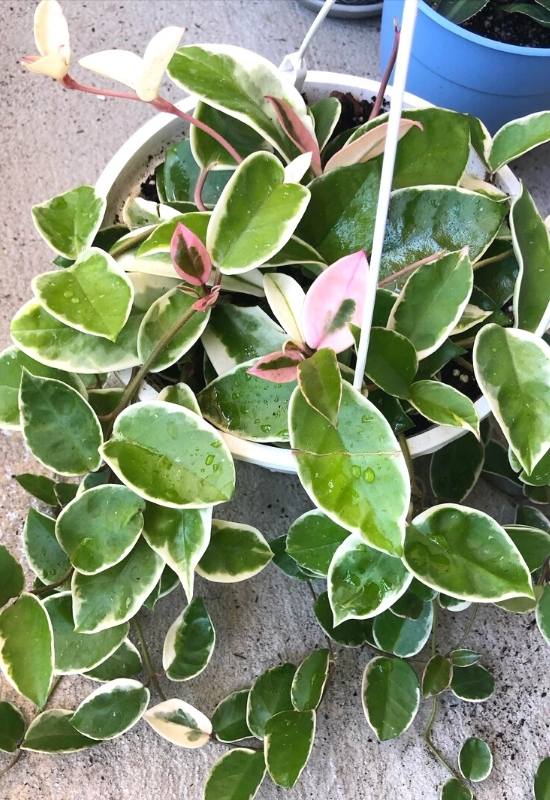
‘Purple Pride’ waxplant is a cultivar of Hoya carnosa variegata with very distinctive and colorful leaves, perfect for a bright and eye catching display all year round.
The leaves are very fleshy, semi succulent indeed. They are also long (3 inches, or 7.5 cm)broad and elliptical, as well as glossy.
They are mostly cream white and mid green, but with sunlight, they also take on pink purple shades – very unusual for a waxvine!
The blooms are felted, star shaped and they are pink in color with a plum corona; and they will delight you with their light but sweet smell. They will come in clusters of about 30, and they will last for about a week.
27: Hoya ‘Bella’ (Hoya lanceolata ssp bella)
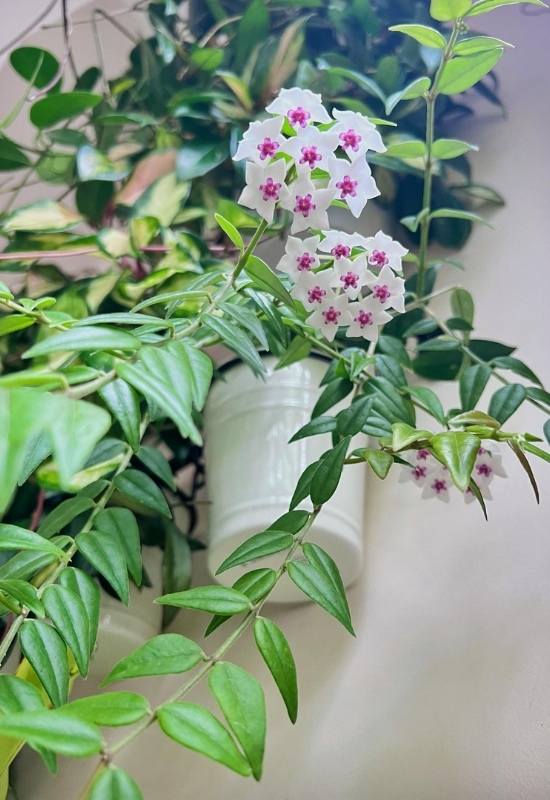
‘Bella’ waxflower is a subspecies of Hoya lanceolata with very elegant plant indeed. The leaves are spear shaped (lanceolate) and pointed, light to mid green and they come in opposite pairs on the long, thin straight and fresh looking vines, which drape containers with sophisticated beauty.
They are small, only about 1 to 1.2 inches long (2.5 to 3.0 cm) but this adds to the open and breezy look of this waxplant.
The blooms are star shaped, small and they come in nodding umbels of 10 to 30 that tend to concentrate at the end of the stems.
It is ideal for an airy room, with lots of light, where it will bring its fine texture and bright blossoms. It is also a fairly small variety, suitable for modest spaces. However, this plant is delicate and sometimes demanding, keep this in mind.
28: ‘Indian Rope’ Waxplant (Hoya compacta ‘Indian Rope’)
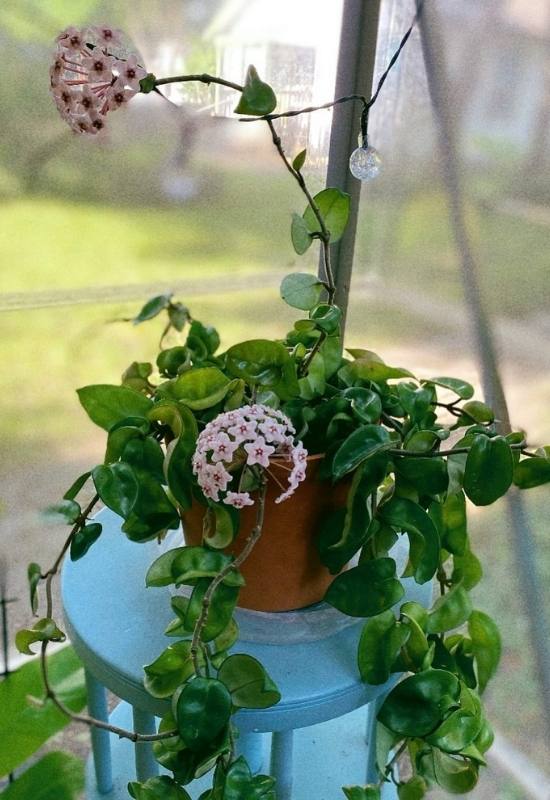
‘Indian Rope’, a cultivar of Hoya compacta, will strike you with the odd shape of its foliage. In fact, the glossy and fleshy leaves are cupped and they twist and curl, which is a very original feature for waxplants.
What is more, this species has very, very dense foliage, and you won’t even be able to see the stems. Finally, they are variegated, with white, pale green and mid green.
However, with light they can take on coral and pink shades too! The flowers have the typical star shape of waxflowers, white and with a red corona.
Small and pretty they come in umbels of up to 50, arguably some of the most numerous of all waxvines. This houseplant is a living sculpture, ideal for a central place in a loving room or office.
29: Hoya Sussuela (Hoya sussuela)
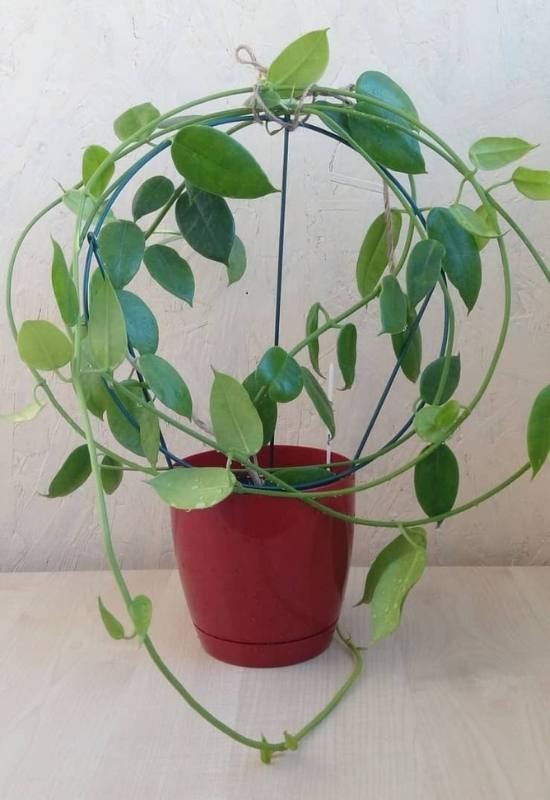
Hoya sussuela is yet another climbing variety with a very individual look and personality. The climbing vines are soft looking, green, the same color as the foliage.
But the leaves, which are elliptical and with a tiny tip, slightly felted, fairly fleshy and glossy, are very much spaced out along the stems.
The slender and airy look of the body of this waxplant is contrasted by the bold and large blooms.
The flowers are star shaped, up to 2 inches across (5.0 cm) and of the deepest maroon color, very glossy and impossible to miss, while the corona is usually yellow.
They also have an original fragrance for waxflowers, as it is musky and very strong. They will open in small clusters, of between 3 and 5 heads each.
As a houseplant, it will mark your originality and grace your rooms with both elegance and showy blossoms.
30: Hoya Curtisii (Hoya curtisii)
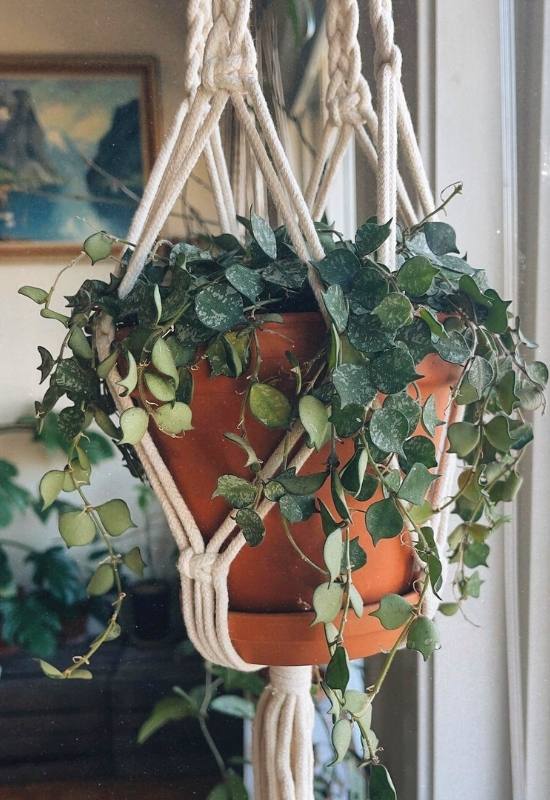
Hoya curtisii is a compact variety of waxplant with very dense and finely textured foliage. The leaves are unusually shaped, with matching width and length, about ½ to 1 inch (1.2 to 2.5 cm).
They are almost round with a lovely tip at the end, a bit like a spade in cards. Add the beautiful and fine variegation of lighter and darker greens in small dots, and you understand why this plant will add texture and color to your rooms.
The blooms are quite unusual as well; the petals are like spikes, very thin, and they reflex as they mature.
The corona, with purple and pink shades, remains at the forefront of the clusters, with up to 30 heads, forming a very elegant and three dimensional decoration.
31: Hoya Odorata (Hoya odorata)
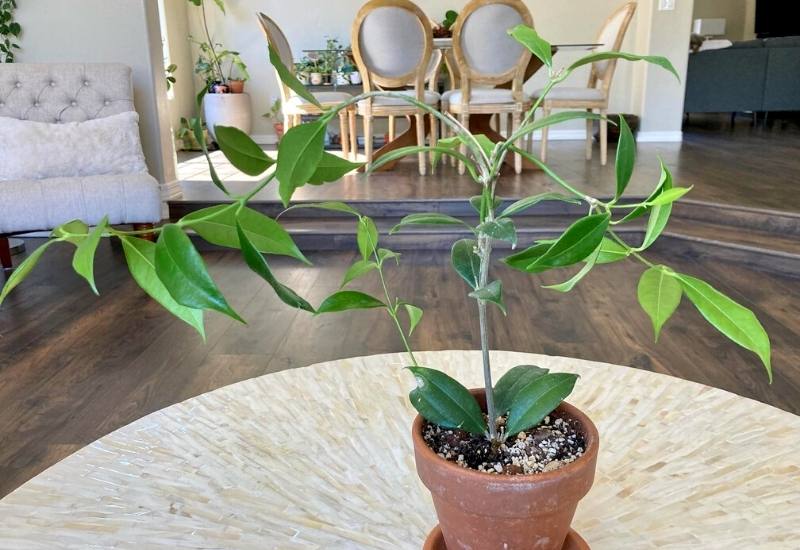
Hoya odorata is one of the most elegant varieties of waxplant, and one with a distinctive smell, as the name suggests.
The thin and arching vines don’t grow downwards like in many wxflowers, but spread out before descending.
The leaves are mid to dark green, elliptical and glossy but not fleshy, fairly spread out and in opposite pairs.
The flowers have a strong fragrance of citrus, and the colors match it; white and star shaped, with long petals and a lemon yellow center, they will come in small and open clusters along the vines.
It is a small species, harmonic in shape and with a good symmetrical texture. I would suggest it for a bright and breezy room, where it can really fit in with look and aroma.
32: Hoya Meredithii (Hoya meredithii)
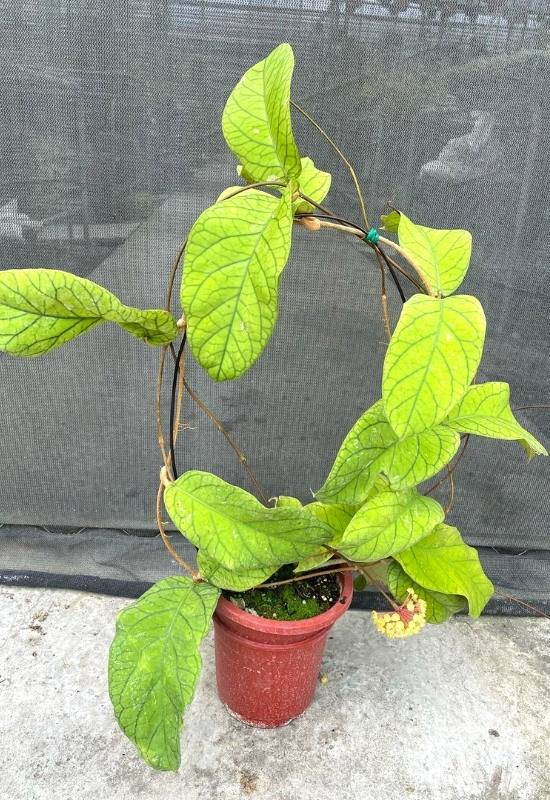
The main decorative quality of Hoya meredithii is the pattern of its variegated foliage. The leaves are in fact bright and light green with an intricate pattern of darker veins that looks like filigree.
They are broad and pointed, often curving slightly, and quite big in size, 4 inches wide (10 cm) and up to 8 in length (20 cm).
This lush display will also host thick umbels of waxy flowers that have the typical shape of the blooms of waxplants; the petals are canary yellow, while the coronas are lighter.
This waxflower is perfect as a houseplant, giving you a similar effect to that of a climbing philodendron.
33: Hoya Caudata Sumatra (Hoya caudata sumatra)
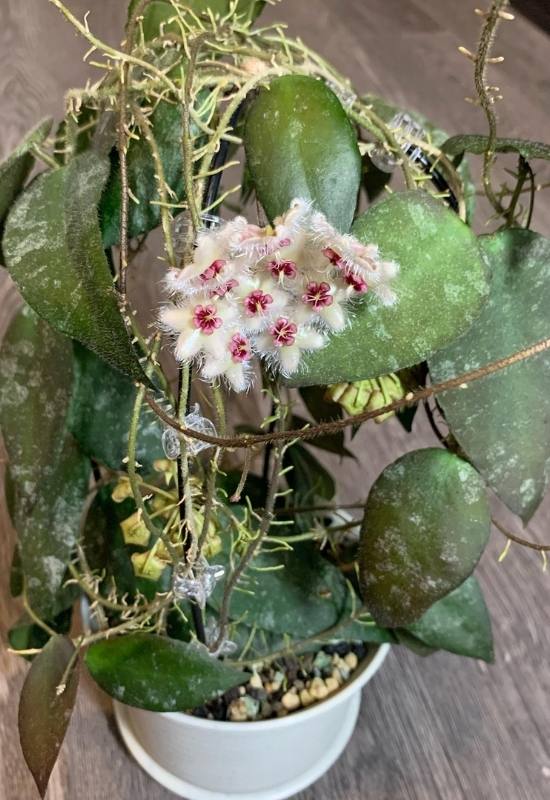
Hoya caudata sumatra is a rare variety of waxplant with distinctive fluffy flowers. The small blooms are star shaped, white and with a purple corona, but covered in a very soft white fuzz.
They will open in umbels of about a dozen heads each. The vines are brown and hairy as well. The leaves are ovate, 2 to 6 inches long (5.0 to 15 cm) and up to 3 inches wide (7.5 cm).
However, what makes them unique is the coloring; they have a darker shade as background, with brighter dashes that look like sanding.
They are usually green, but in some cases, they turn into a very dark shade of purple. This is a very expensive plant, given its rarity, and you can only find it in very specialized shops.
34: Hoya Hellwigiana (Hoya hellwigiana)
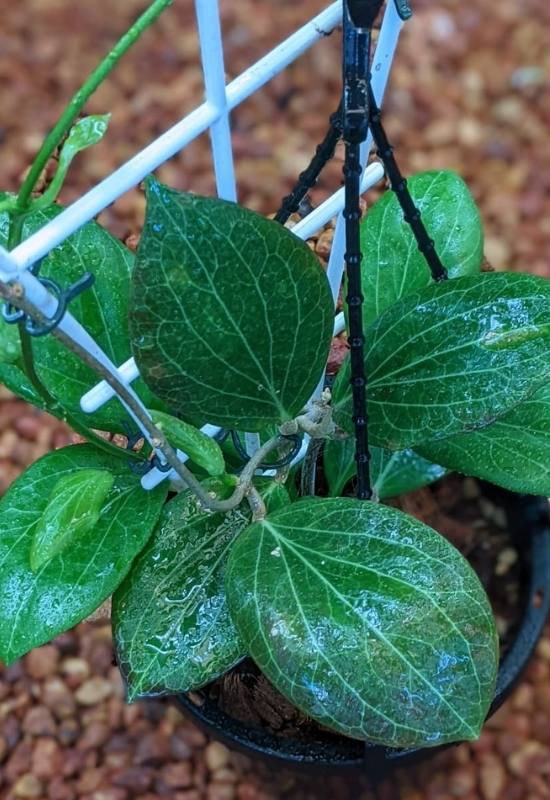
Hoya hellwigiana offers you, your home or your garden broad and long leaves with veins in clear relief and a little twist… reaching 5 inches long (12 cm) and 2.5 wide (6.0 cm), these are usually mid green but they can turn red and even purple if this waxplant gets enough light!
The umbels contain up to 30 flowers each, with a distinctive smell of lemon, so, very fresh indeed. The petals look soft and like candle wax indeed.
They are cream in color and they will reflex very harmonically leaving the white coronas on the outside of the clusters, that can be spherical in shape.
Giving you a three dimensional bloom and colorful foliage, this waxflower has the best of both worlds.
35: Hoya Krohniana (Hoya krohniana)
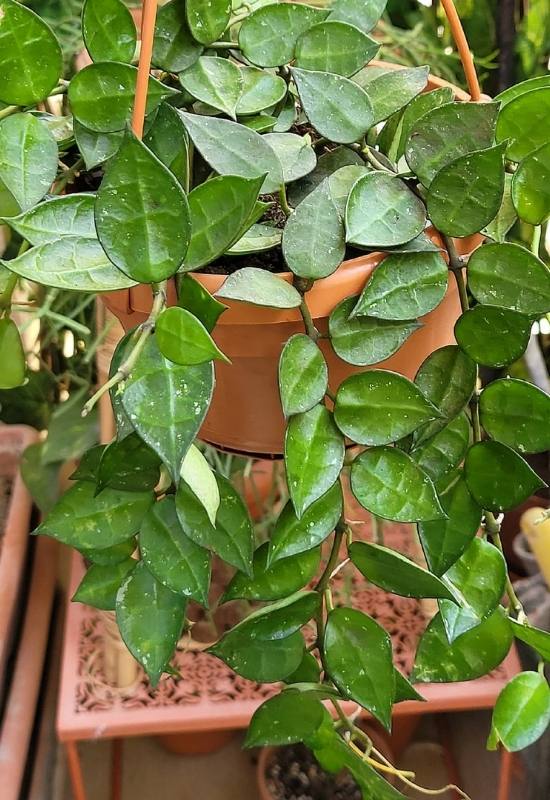
If you like heart shaped foliage, you will love Hoya krohniana. This waxplant has small, cordate leaves that grow elegantly in opposite pairs on the soft stems.
They are light green, but with even brighter tiny specks or dots on them, and fairly fleshy. Some varieties, like the cultivar ‘Super Eskimo’ are basically cream white with dark green points on them.
The flowers have a softened pentagonal shape, almost round, with thick petals that are covered in a shiny white fuzz. They look like they are covered in dew all the time. The coronas, then, are golden to lemon yellow.
The blossoms have a very strong fragrance, especially are night. This is a small trailing variety which can give you lots of sweetness both indoors and outdoors.
36: Hoya Padangensis (Hoya padangensis)
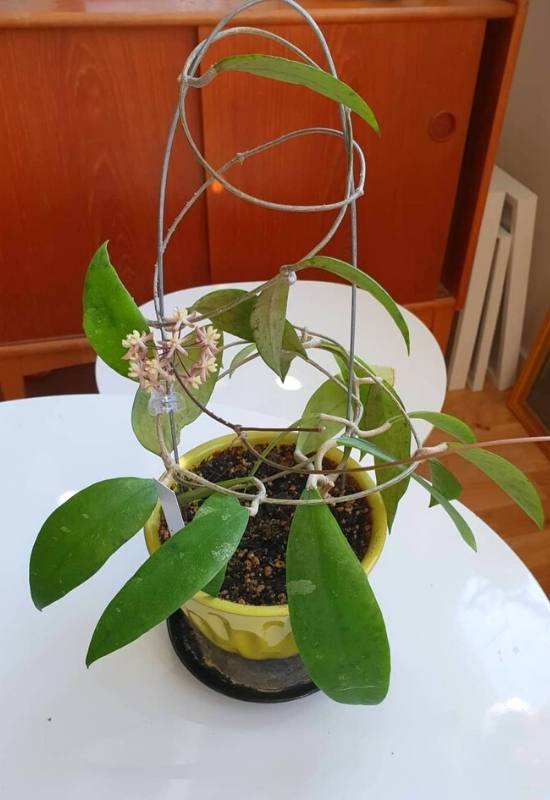
Hoya padangensis has a very slender and elegant look in both foliage and blooms. The leaves are mid green and thin, with slight lighter patches on them.
Each can reach 5 inches long (12.5 cm) and only 1.4 in width (3.5 cm); they arch beautifully and they have a pointed end, growing spaced on the climbing vines.
This theme is repeated in the flowers, which have pointed and long petals, which curve inwards. With delicate pink to purplish tips, the flowers are white and the coronas yellow.
The umbels are airy, open and with only up to 8 blossoms each. This variety of waxflower is ideal for open, light filled rooms with a smart and even minimalist design.
37: ‘Black Dragon’ Waxflower (Hoya pubicorolla ssp. anthracina ‘Black Dragon’)
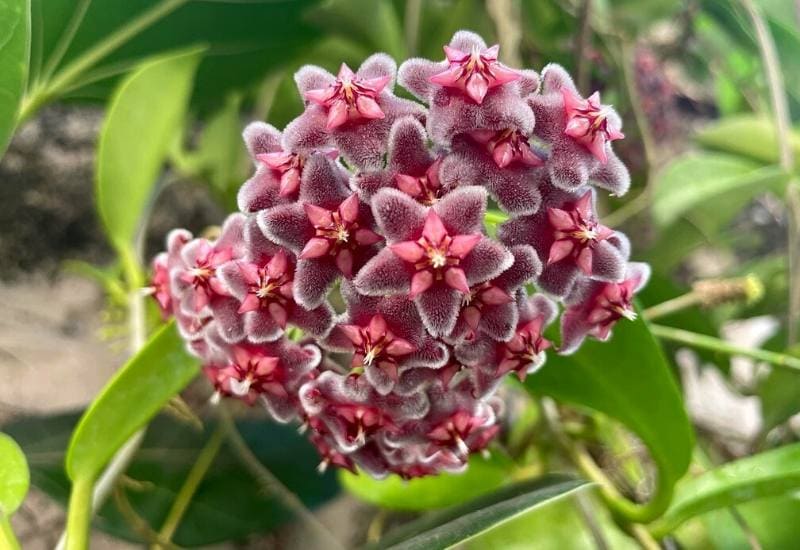
‘Black Dragon’ is a variety of waxflower that takes its name from the amazing color of the blooms.
The star shaped flowers have a deep burgundy shade, which reflects light like in a precious and rare gem stone, and it’s almost black, in gardening terms.
The petals also have a white fuzz on the margins that heighten the effect, while the coronas have ivory, red and pink purple in them.
The umbels are very thick and spherical, with up to 30 heads each. The leaves are long, elliptical and pointed, fairly glossy and mid green.
Each can reach 5 inches long (12.5 cm) and it will also arch lightly. This climber is regarded as the darkest of all waxplants, and it will bring a gothic look to your living room or office.
38: Hoya Merrillii (Hoya merrillii)
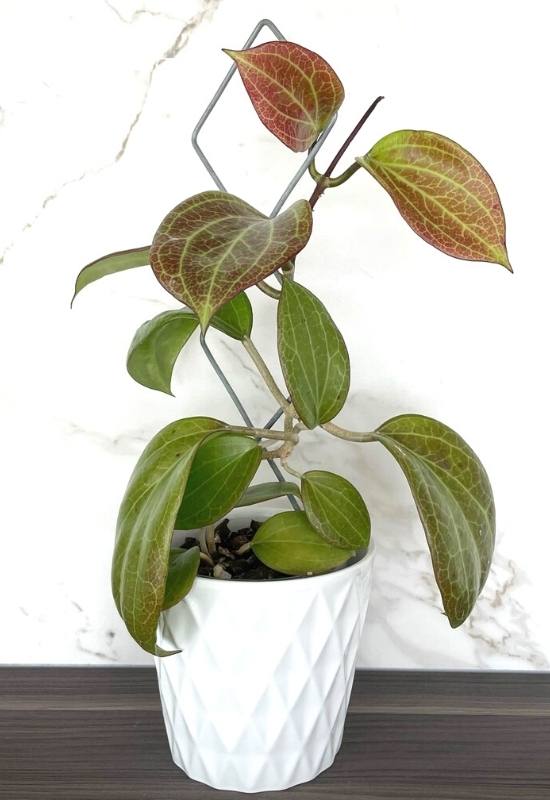
Hoya merrillii is a waxvine with very decorative foliage. The leaves will form denser clumps at the base of the vine, and they are oval, broad and paddle shaped, fairly fleshy and incredibly glossy.
You will see green shades that range from light to avocado green, but this plant may even surprise you with wine red hues with good sunlight. Beautiful lighter veins will add interest to this display.
They are very large, up to 1 foot in length (30 cm) and 8 inches in width (20 cm). This is a climbing variety, and the flowers are star shaped, with long petals, usually yellow, from lemon to golden and even mustard, but in some varieties cream, white and faint pink.
They are arranged in spherical clusters of up to 30. This is one of the most generous waxflowers, ideal as a houseplant for its showy appearance.
39: Hoya Latifolia (Hoya latifolia)
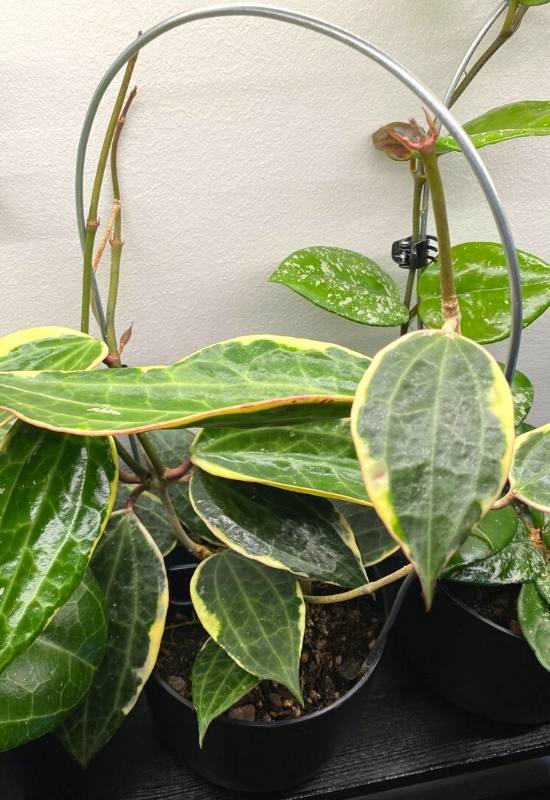
The scientific name Hoya latifolia means “broadleaf waxplant” and it is a fitting description. The leaves are in fact very wide, up to 6 inches (15 cm) and even long, 10 to a whopping 25 inches (25 to 63 cm).
On top of this, they are slightly heart shaped and fleshy, very glossy and with beautiful veins on them. Their color is quote dark, depending a bit on light exposure however.
The spherical umbels are record breaking too, with up to an amazing 260 individual flowers each!
The blooms can be of different colors in the white to pink purple range, usually with darker coronas. This is a record breaking climbing variety of waxflower, sure to wow your guests!
40: Hoya Callistophylla (Hoya callistophylla)
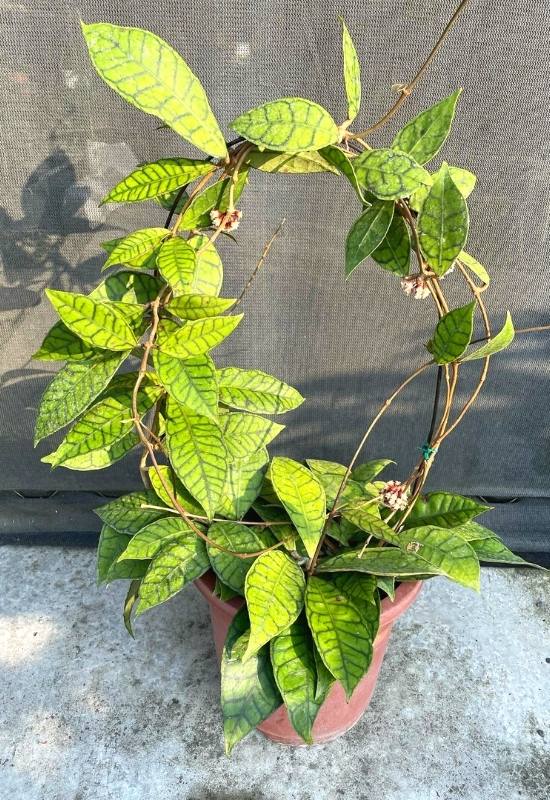
If you look at Hoya callistophila, snakes may come to your mind. The fact is that the leaves are divided like in scales by dark green stripes that follow the veins, cutting over a much lighter background.
They are elliptical, long and pointed, not fleshy but glossy, and they also arch slightly. The contrasting effect is striking and decorative, and consider that they can be 10 inches long (25 cm)!
This climbing waxflower will also bloom with round umbels of very colorful flowers. Containing up to 30 each, the petals are deep purple at the tips, red in the middle and the yellow towards the center. The coronas are usually cream white. This is is the waxflower of contrasting colors for a very dramatic effect!
Hoya Or Waxflower: A Beautiful Vine!
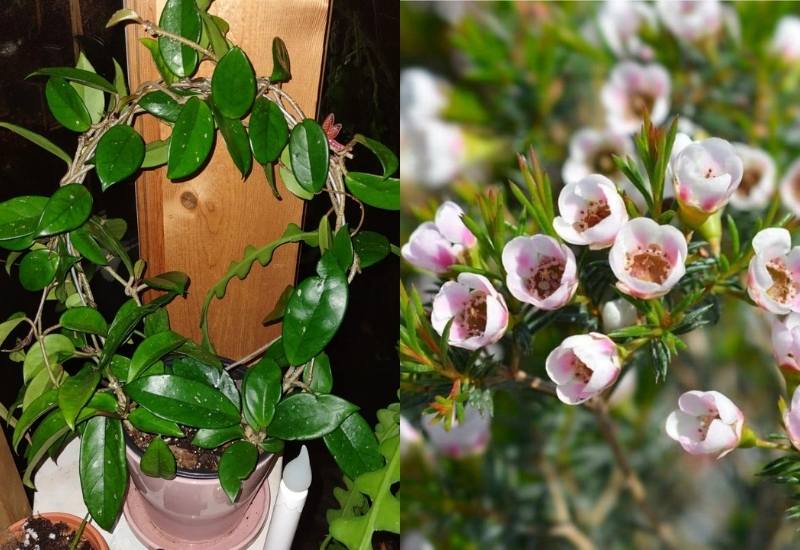
Many people think that hoyas, or waxflowers, are all a bit the same, maybe because many have small flowers, but now you have seen these 40 varieties you must admit that there are many different types of waxvines, and they are all absolutely beautiful!

Written By
Amber Noyes
Amber Noyes was born and raised in a suburban California town, San Mateo. She holds a master’s degree in horticulture from the University of California as well as a BS in Biology from the University of San Francisco. With experience working on an organic farm, water conservation research, farmers’ markets, and plant nursery, she understands what makes plants thrive and how we can better understand the connection between microclimate and plant health. When she’s not on the land, Amber loves informing people of new ideas/things related to gardening, especially organic gardening, houseplants, and growing plants in a small space.

Thank you for all the info and the great pictures!
Wonderful information on Hoyas! I was happy to see I own some of these and looking forward to getting some of the others. Soil info was perfect!